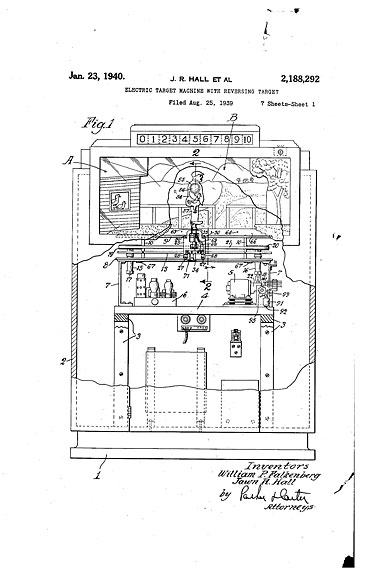Contents:
Introduction
Play
General Description, Components
How It Works
History
Restoration Part 1
Restoration Part 2
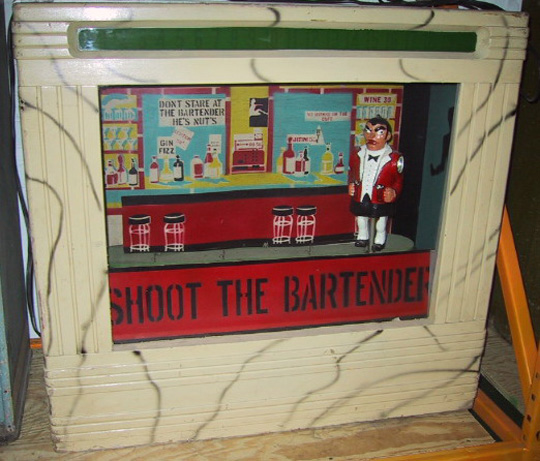
Seeburg and Rayolite Companies developed many games using the Rayolite technology. Seeburg sold upgrade kits to change the theme. Operators often changed the look and theme of the games while attempting to make the games appear new and interesting. Some changes were crude and others were sophisticated.
Dry History
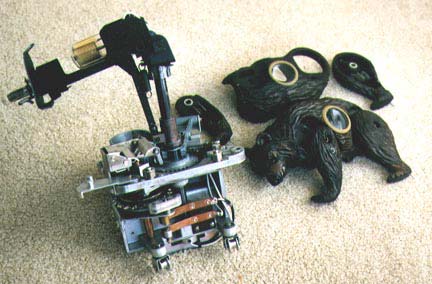
This is a re-write of the original. I spent more time researching this, looking up new patents, and being more careful about the history.
Patent History
Investigating patents tells me many things about the development of various games. The original designer intentions appear in the patent when he was inventing the game. The rules, original concepts, wiring, mechanicals, and even mistakes are evidenced in each patent. The inventor's career can be traced through the types of inventions and the companies for whom he worked.
Patents are an valuable tool for completing restorations. Original wiring diagrams, mechanical drawings, and rules help describe how a mechanism is supposed to function. An example is the difficulty I had getting the light bulb to work correctly. It burned out easily, and the reason was explained in one of the patents. Rules are another example. Games were often modified on location, for reliability reasons or to improve the commercial value. Attending to the original rules restored the game to the original condition, as intended by the designer.
Sometimes the world of corporate acquisitions also becomes evident. Rayolite started originally in Oklahoma in 1934. Seeburg started building the games under license and then later took over the company some time between 1943 and 1945. The engineers who originally developed for the Rayolite system then worked exclusively on jukeboxes, with development of the Rayolite system stopping.
All the patents I found were assigned to the Rayolite Rifle Range Company of Tulsa, Oklahoma. It appears the company moved to Chicago before May 31, 1938. I found no patents issued to Seeburg, suggesting perhaps that Seeburg made the games under license. It is also possible Seeburg purchased the Rayolite Company after 1942
Inventions:
Charles Griffith invented the Ray-O-Lite system in 1935. It consisted of a rifle capable of shining a ray of light across the room and illuminating a target. The target could detect a hit. He spent no time creating interesting targets, concentrating only on the rifle mechanism and the light source.
Alva Carter concentrated on perfecting the trigger mechanism for the gun. He concentrated on making sure the light only stayed on for an instant, in response to a trigger pull. It was easy to follow the target with the light beam, effectively causing a hit. This was not like shooting a metal bullet, which cannot be directed along a path once shot. Carter also worked to prevent false hits caused by light shining from other sources. He tried some mechanical methods for shuttering the light but finally concentrated on electrical methods of turning the light on and off.
William Falkenberg was an operator in Los Angles and operated these games on a route. He wanted better targets and started developing them himself. He had help from Carter, Reginald French, and Fred McClellan. Targets started off as birds and ducks, often simulating a shooting gallery theme. Later more humorous targets were created, like a hobo running off with a farmerís chicken or a mechanical dog chasing a bear. Jawn Hall and Falkenberg worked in Los Angles for some of the time, developing the mechanicals of the targets, like the reversing mechanisms, which added realism to the target.
Once the Rayolite system became popular, many inventions flowed to support the enhancements.
Advertisements
The first advertisements appeared in 1935 and 1936, advertising a Rayolite Rifle Range and showing a single flying duck as a target. The player received 10-20 shots for a nickel, and the J. P. Seeburg Corp., located at 1510 North Dayton Street in Chicago manufactured the game. Price was $495. There was an endorsement by F. R. Moulton, formerly a major in charge of ballistics for the United States Army during the world war.
The ad was repeated in 1936 and included operator testimonials about the earning power of the games. Included was one from W. P. Falkenberg of Los Angles, California. He mentions 25 Ray-O-Lites in operation with one at Barney's Beanery, "a very popular place, yet so small that you have hardly room to change your mind." He later became so interested in these games he started to develop targets for them and gain patents.
Seeburg advertised the Multi Rayolite Rifle Range, showing Chicken Sam in 1939. In 1940 they marketed the same game with a prison theme, called Jailbird. A war theme, Shoot the Chutes, was also advertised, date unknown. The targets were parachutes and were stationary. They would illuminate to show they were active. Seeburg was now located at 1500 Dayton.
In 1944, flyers appeared advertising Shoot the Bear and Coon Hunt using the Rayolite Rifle Range.
I also have a lubrication chart, showing a raccoon target and a wonderfully complex mechanism used to make the target move realistically, and I assume it is from Coon Hunt.
Patents
The first patent I found, directly related to the Ray-o-Lite systems was dated July 2, 1935 and was issued to Charles W. Griffith and the Rayolite Rifle Range Company of Tulsa, Oklahoma. This patent showed only the rifle creating a beam of light and made no claims about what the target looks like. It shows drawings of a rifle, light, and trigger mechanism and was filed in April 1934. Awarded on the same day was another patent that showed the mechanicals of a movable target, but it was filed in August 1934.
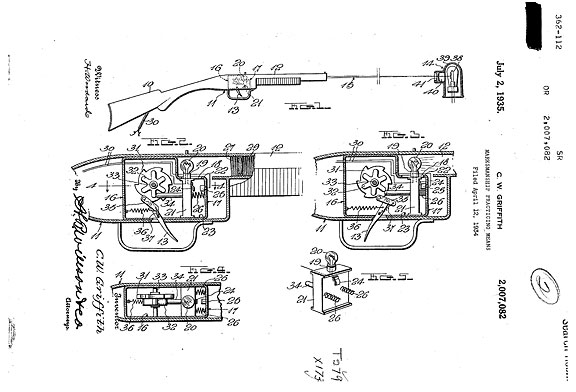
The target patent showed a duck moving on a horizontal belt. There were provisions for making the target look like it was knocked down in response to a hit. There were also provisions for keeping track of the number of hits and the circuits supported operation by insertion of a coin.
There was a flurry of patent applications made in 1936, most in response to improvements to Griffith's original patent. Many were granted over the next several years, some requiring resubmission and not being granted until 1940, almost four years later. The only thing in common with them all was the assumption of a light beam triggering a hit. Some patents focused on preventing fraud by trying to limit the beam to an instant and ignoring any light hitting the target if the gun was not triggered. Other patents tried to make the targets more realistic and varied. Some tried to do this by making multiple targets and illuminate them while others focused on animating single target in interesting ways.
On May 31, 1938, another patent, issued to Alva J. Carter and the same company, shows improvements to the trigger mechanism and shows a target this time. The entire patent discusses improvements in shuttering the beam of light. There is a duck target, appearing to rotate round in a circle and only be visible at the top of the circle, but no mention of the target appears in the patent. The company has now moved to Chicago, Illinois.
The next target patent was given on October 4, 1938, to Carter. This patent contained the first schematic and showed the moving photo cells on the targets. It provided for limiting the number of shots and for keeping score. It provided for feedback to the player upon hitting a target. The drawings show two ducks on a rotating mechanism. The rotation motion stands the target up, rotates the duck into view, and knocks the duck down if hit. The ducks just rotate on a wheel, up and down.
A patent for a squirrel target was issued to Reginald D. French on February 28, 1939. It shows a squirrel running up a tree, and moves the photocell along with it. Each hit would move the squirrel up and the movement would cause the tail to twitch. There is an implication that a more direct hit would create a stronger electrical current and make the movement greater. The better shot the player was would move the squirrel higher. By placing two games side by site, competitors would race their targets to the top, with the head-to-head battle increasing revenue.
William B. Falkenberg obtained the next patent on May 23, 1939. This patent provides for a moving duck target, with the ducks being held upright until they are shot, for a chime sounding upon a hit, and to keep track of the score. The target is also centered at the end of the game so the next player understands the nature of the game and the target. This patent is great reading because the full mechanics of the ducks are illustrated, along with a schematic! Falkenberg, as an operator, realized the value of keeping the target visible at the end of the game, thus attracting the next player.
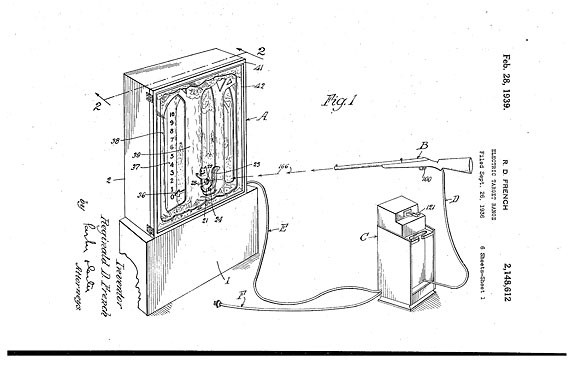
Falkenbergís next patent, issued on November 21, 1939, depicted a game that looked like a coo coo clock. The target was on the end of the pendulum and would swing back and forth. Hits were indicated by a bird opening a door at the top like a coo coo and the dial of the clock showed the number of hits. Here was also the first mention of using other than visible light to trigger the target, including ultraviolet, infrared and even radio waves.
On December 5, 1939, Fred C. McClellan was issued a patent for a different kind of target, not containing any moving pieces. The active target was illuminated only for a short time, requiring the player to find, aim, and shoot a target quickly. Then the target flashes a red light behind it to signify a hit. When not illuminated the targets are not visible.
The Rayolite Rifle Company was also concerned with cheating. Nathan E. Squire was issued a patent on January 23, 1940 for circuitry and devices to prevent the player from using another beam of light to trigger a hit. The inventors continued to look for ways to limit the duration of the light beam. A player might continue to swing the rifle and track a target, with the duration of the light beam giving them a longer window of opportunity to record a hit. This patent was originally assigned to the Ford Amusement Devices and is found listed on the Patent Plate on Shoot the Bear.
Also issued on the same date to Jawn R. Hall and Falkenberg was a patent for a reversing target. This shows Chicken Sam, a hobo or tramp, trying to run off with a farmerís chicken. The drawings show an oblong track, with a target powered by a motor and chain. The target reverses direction when hit, similar to Shoot-the-Bear.
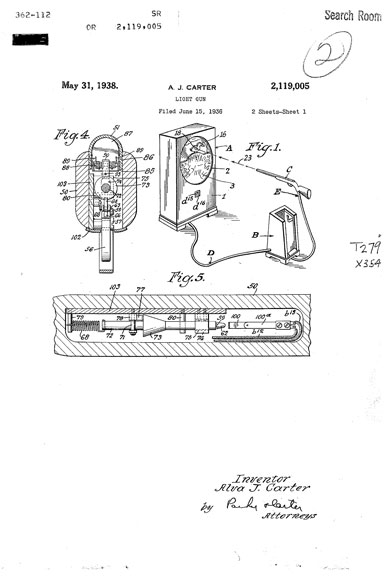
These complete the applications filed for in 1936. There were more patents of interest that were issued in 1941 to Archie J. McMaster. The first was an unrelated one for an electric contact. This electric contact is seen in all the bingo pinball machines and is for an insulating disc with metal buttons radiating out from the center and a tracking bar with spring mounted pins that sweep over the buttons. This patent was assigned to G-M Laboratories.
The same year, McMaster was awarded a patent for a tabletop version of the Rayolite system. It shows a pistol shooting down a glass case, with targets at the other end. There were many elegant solutions to many of the problems with the Rayolite system, including a solenoid-operated shutter to trigger the light beam. The solenoid also caused a recoil sound and vibration in the gun itself. The targets were illuminated and active only for a short time. He used a air column with the target only being active as long as it took for the solenoid to drop down to the bottom. The ten targets were illuminated twice, in a pseudo random order, using the above mentioned invention and the game was over. Shots were not counted and a target was either hit or not during its active time.
The first gun stand is the subject of the next patent, issued on June 2, 1942 to Mahlon W. Kenney and Herman G. Jensen. It allows for the coin mechanism and coin control, and for the cradling of the guns, and even incorporates the amplifier to make the stand more stable.
The art of target making continued on January 6, 1942, as Falkenberg patented both moving and stationary targets. This was probably an attempt to make the game appeal to an audience not accustomed to shooting a gun. A stationary target is easier to hit. His patent showed an owl as a target and mentions simulating an additional coin drop in response to a perfect score.
On March 3, 1942, Mahlon W. Kenney and Herman G. Jensen were issued another patent for a target system that showed Chicken Sam. It did not seem to differ substantially from pervious patents. This one did mention pre-heating the filament of the gun lamp in order to make it more reliable. An identical patent was issued again on January 19. 1943. The drawings and figures are identical, as is the explanation. The claims at the end go into more detail.
I found no further patents assigned to the Rayolite Corporation. In 1945 other patents relating to jukeboxes were issued to the Seeburg Corporation and the same inventors that used to work on the Rayolite system. Notably Jensen, Kenney, and Carl Johnson had moved over to helping develop the jukebox.
